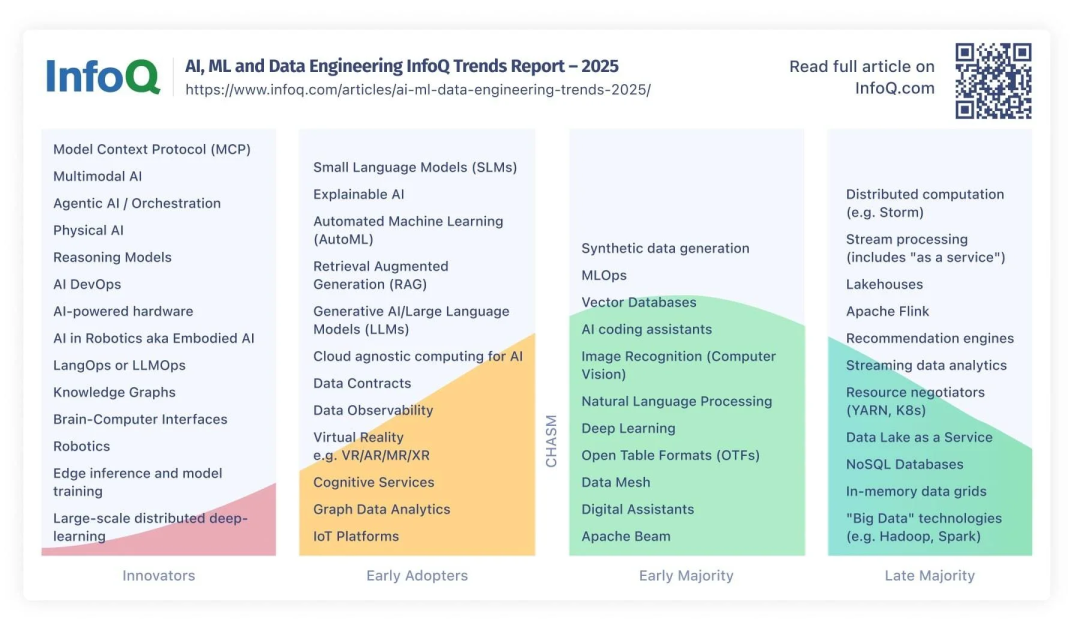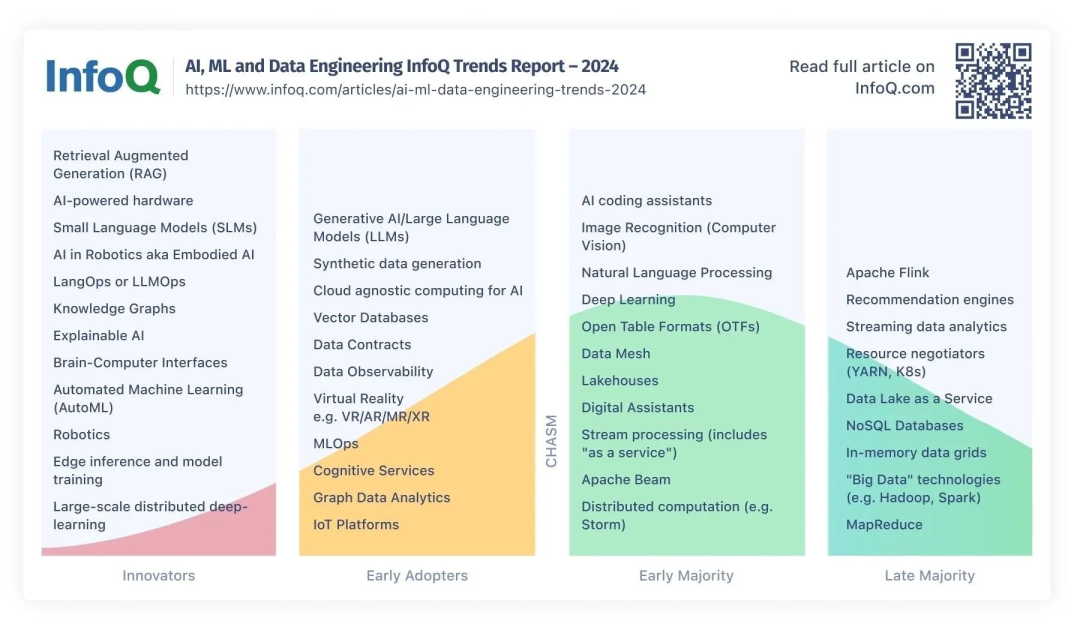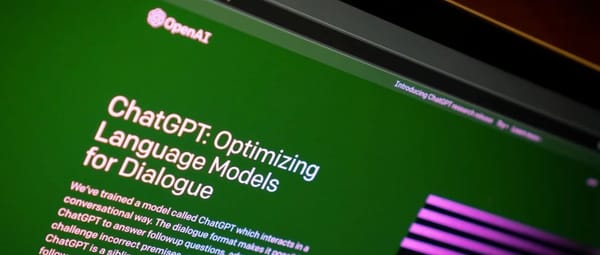2025 InfoQ Trends Report: AI, ML, and Data Engineering

InfoQ AI & ML Trends Report — Emerging Technologies and Insights


The InfoQ AI & ML Trends Report offers a comprehensive look at emerging trends and cutting-edge technologies in artificial intelligence (AI), machine learning (ML), and data engineering.
Drawing on podcasts hosted by the InfoQ editorial team with industry guests, the report presents a forward-looking view on the direction of AI/ML for the next 12 months. A companion podcast series offers deeper insights into each trend.
---
AI & ML Trend Graph
The trend graph is a central feature of our annual report.
- It visualizes which trends have entered the Innovator stage and which have advanced to Early Adopter or Early Majority.
- These stages are derived from Geoffrey Moore’s Crossing the Chasm framework.
- InfoQ focuses on technologies that have not yet crossed the chasm.

Since ChatGPT’s release in November 2022, Generative AI and Large Language Models (LLMs) have dominated discourse. Industry leaders continue to iterate with higher-performance models.
Innovation has accelerated since last year’s report — see the 2024 trend graph below:

This article covers:
- Trends at different adoption stages
- New/updated technologies since last year
- Upward movement in the adoption curve
---
Key Changes Since Last Year
Innovator Stage — New Entries
AI Agents
AI Agents have evolved rapidly:
- From single-task bots to multi-step orchestration systems
- Integration with spreadsheets, presentations, and cloud resources
- Recent releases:
- Anthropic’s Claude Subagents
- AWS Bedrock Agents
- AWS open-sourced Strands Agents SDK
- NVIDIA’s Visual AI Agents
Expert Insight – Daniel Dominguez:
> We’re seeing AI agents move beyond chatbots into task orchestration, AWS service integration, and secure data interpretation — helping enterprises move from prototypes to production.
Key Risks:
AI agents can execute shell commands or access system functions, posing security challenges if not safeguarded.
Practical Applications:
Open-source ecosystems like AiToEarn官网 connect AI content generation with cross-platform publishing/analytics — allowing creators to deploy AI-generated content to Douyin, Kwai, WeChat, Bilibili, Xiaohongshu, Facebook, Instagram, LinkedIn, Threads, YouTube, Pinterest, and X.
---
Multimodal Language Models
Language models now integrate text, images, audio, and video, enabling richer and more contextual outputs.
---
Physical AI
Physical AI refers to embodied AI in robotics — combining on-device AI and robotics innovations.
Notable Developments:
- Google Gemma 3n: On-device generative AI for smartphones/laptops
- Microsoft Mu: On-device small language model (SLM) for Windows
- Google Gemini Robotics On-Device: Vision-Language-Action models for robots
- NVIDIA AI Robotics Stack:
- Training: NVIDIA DGX
- Simulation: NVIDIA Omniverse, Cosmos
- Inference: NVIDIA Jetson AGX Thor
Expert Insight – Savannah Kunovsky:
> Edge computing strengthens user trust in Physical AI, allowing sensitive home data to be processed locally.
---
Model Context Protocol (MCP)
Introduced: November 2024
Purpose: Unify LLM tool/data integration across vendors.
Adopters: OpenAI, Microsoft, Google.
Benefits:
- Cross-model interoperability
- Multi-agent system collaboration
Challenges:
- Context window limitations
- Security concerns on MCP servers
---
Human–Computer Interaction (HCI) Advancements
AI-enhanced interfaces are transforming user interaction:
- Need for better prompting and interaction design
- Concepts like Apple’s Liquid Glass and MIT’s Fluid Interfaces aim for context-embedded information, reducing reliance on traditional devices.
Kunovsky stresses:
> Design must align with human contexts — not force adaptation to machine constraints.
---
Early Adopters
Language Model Innovations
Major developments include:
- OpenAI GPT-5
- Visual LLMs (VLMs) — e.g., OpenAI Sora for generative video
- Small Language Models (SLMs) for privacy/on-device use
- State Space Models (SSMs) and diffusion models
Key Podcast Notes:
- OpenAI’s shift to simplified naming and model size variations
- Interface simplification to support mainstream adoption
---
Retrieval-Augmented Generation (RAG)
RAG adoption is accelerating in enterprises — especially for large knowledge repositories.
Savannah Kunovsky highlights:
> Designers can now pre-load deep organizational context via RAG, enabling more informed creative work.
---
Early Majority
Technologies moving into widespread development adoption:
- Vector Databases
- MLOps
- Synthetic Data
---
Late Majority
Fully integrated, standard technologies:
- Data Lakes
- Stream Processing
- Distributed Computing (Storm)
---
Summary & Predictions
AI’s trajectory is shifting from tactical assistants to strategic partners:
Predictions for 2025:
- Continued advancement in AI agents and AI coding tools
- Emergence of Video RAG
- Discussions of an AI industry bubble
- Enhanced contextual, behind-the-scenes AI functionalities
Creator Ecosystem Impact:
Platforms like AiToEarn官网 enable AI-powered content monetization across global channels. Integrated with analytics and model rankings (AiToEarn文档), these tools democratize participation in the AI-driven economy.
---
References
- Original InfoQ Article: https://www.infoq.com/articles/ai-ml-data-engineering-trends-2025/
- Related Reading:
- "Your Agent? I Can Build It in a Weekend!"
- "Failing Over a Dozen Times in 5 Months"
- "A Single Battery Cripples South Korea"

---
This improved Markdown now has clear headings, bullet lists, bold emphasis, and logically grouped content for better readability. Would you like me to also produce a visual infographic version of the adoption curve based on this text?


